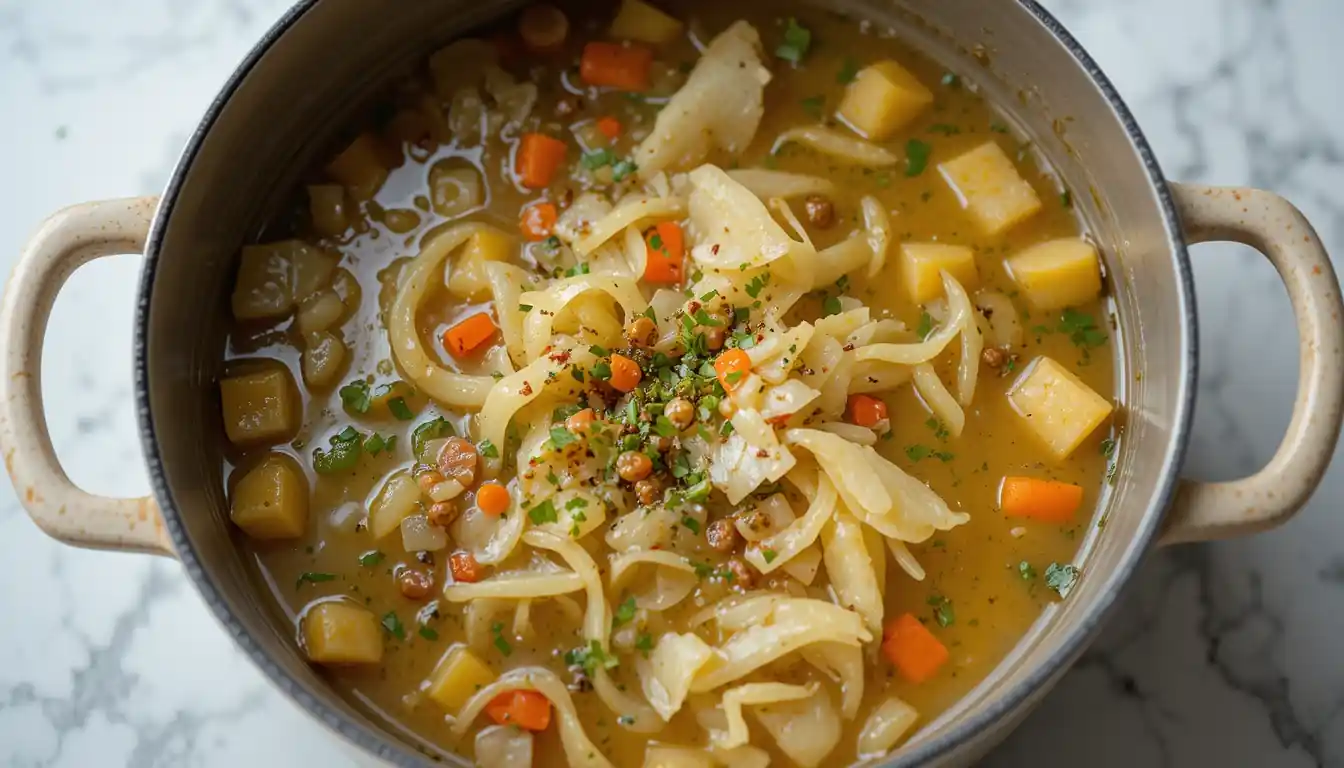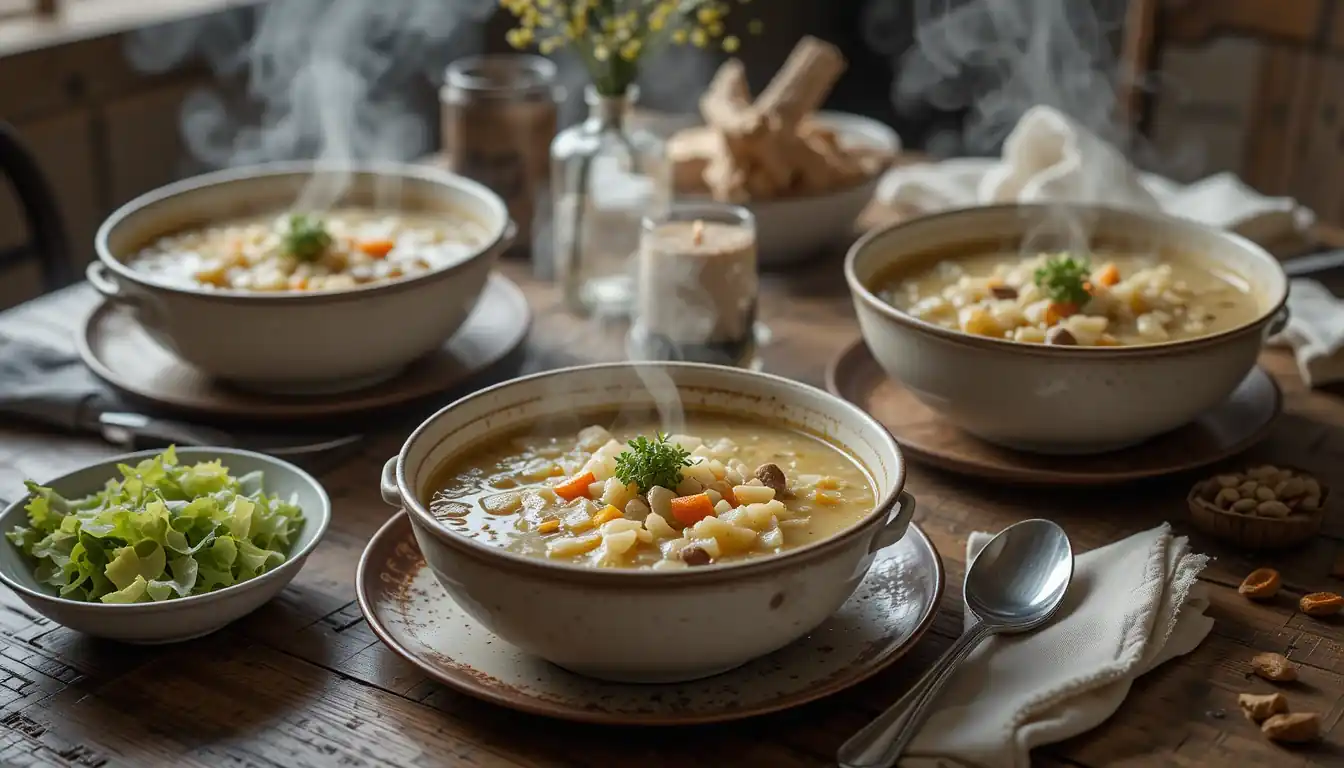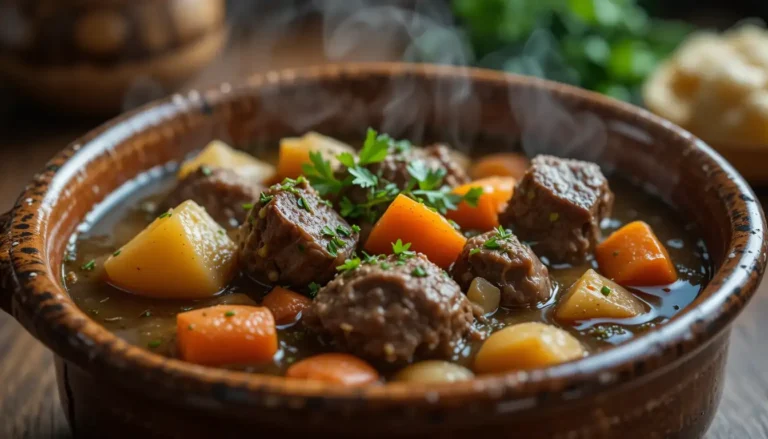Incredible German Sauerkraut Soup: Ultimate Comfort
Cooking can be as much about preserving tradition as it is about creating new memories. German Sauerkraut Soup is a beloved dish that marries the tang of fermented cabbage with savory meats and robust vegetables. This recipe not only delivers a satisfying meal during chilly weather but also carries the rich culinary heritage of Germany. Whether you are an experienced cook or a beginner in the kitchen, this article will guide you through each step of preparing a perfect pot of German Sauerkraut Soup.
A Taste of Tradition
The focus keyword “German Sauerkraut Soup” is not just a name—it represents a way of life steeped in culture and history. This soup has long been a staple in German households, cherished for its unique blend of sour, savory, and spicy flavors. At its heart, the soup celebrates the art of fermentation, using sauerkraut as its superstar ingredient. In this article, you will learn about the origins of this rustic recipe, explore its health benefits, and follow a detailed, step-by-step guide to preparing your own German Sauerkraut Soup at home.
History and Background
The German Culinary Heritage Behind the Soup
German Sauerkraut Soup has its roots deep in European culinary traditions. Sauerkraut, or fermented cabbage, has been a part of German cuisine for centuries, largely due to its ability to be preserved during long winters. The fermentation process not only enhances the flavor but also boosts the nutritional profile of the cabbage by creating beneficial probiotics. Over time, skilled cooks in Germany learned to combine sauerkraut with smoked meats, potatoes, and a medley of spices, resulting in a hearty soup that was both delicious and nourishing. Today, German Sauerkraut Soup remains a testament to Germany’s resourcefulness, turning simple ingredients into a robust comfort food that warms the body and delights the palate.
Ingredients for the Perfect German Sauerkraut Soup
Fresh and Authentic Ingredients

Making a traditional German Sauerkraut Soup requires ingredients that contribute distinct flavors and textures. The following elements create a lively mix where every bite bursts with character:
- Sauerkraut: The star of this dish. For an authentic taste, use high-quality, naturally fermented sauerkraut. Rinse it lightly to remove excess brine if you prefer a milder taste.
- Smoked Sausage and/or Bacon: These meats add depth and a smoky flavor. While smoked sausage provides a rich, round taste, bacon offers crisp texture and intensified flavor. You can use either or combine them for a robust profile.
- Potatoes: Diced potatoes not only make the soup more filling but also help to balance the acidity of the sauerkraut.
- Vegetables: Onions, carrots, and celery are classic additions and create a savory base for the soup. They enrich the broth with their natural sweetness as they cook.
- Broth: A well-flavored chicken or vegetable broth is essential. It ties the ingredients together, forming an aromatic and comforting liquid foundation.
- Spices and Herbs: Bay leaves, caraway seeds, black pepper, and fresh thyme are traditionally included. These contribute subtle hints of warmth and spice that enhance the overall flavor.
- Optional Elements: Some recipes call for apples or white wine to add a touch of sweetness and additional acidity. These ingredients can help to mellow the tang of the sauerkraut.
Step-by-Step Preparation
Prepping the Vegetables and Meats
Begin by preparing all your ingredients. Rinse the sauerkraut if you desire a less intense flavor, and drain any excess liquid. Dice the potatoes and carrots into bite-sized pieces, and chop the onion and celery finely. Next, slice the smoked sausage into rounds or half-moons and cut the bacon into small strips if you are using both.
Heating a large pot over medium heat, add the bacon first to render its fat. Once crisp, remove the bacon bits and set them aside. In the fat that remains, brown the smoked sausage gently. This initial browning process is crucial—it builds an early foundation of rich flavor that will permeate the soup as it simmers.
Sautéing and Combining Flavors
After browning the meats, add the chopped onions, carrots, and celery into the pot. Sauté the vegetables until soft and translucent, allowing them to absorb the flavors left behind by the bacon and sausage. This stage is all about creating a flavor-rich base for your soup.
Once the vegetables are reduced and slightly caramelized, stir in the sauerkraut. Allow the sauerkraut to mix thoroughly with the sautéed vegetables, infusing the dish with its characteristic tang. This is also the moment to add your spices—drop in the bay leaves, sprinkle in the caraway seeds, and add a dash of black pepper. If you’re using white wine, pour in a splash now, letting it reduce slightly to concentrate its flavor.
Simmering to Perfection

After these initial steps, it’s time to add the broth and potatoes to the mix. Pour in enough broth to cover the ingredients by about one inch and bring the mixture to a boil. Once boiling, reduce the heat to a simmer. Cover the pot and let it cook gently. The simmering process, which should last between 30 to 45 minutes, allows all the flavors to meld beautifully together.
This step is crucial because it gives the soup time to infuse the tangy tang of the sauerkraut with the rich, savory notes of the meats and the sweetness of the vegetables. Taste the broth occasionally and adjust the seasoning if needed. If you find the soup too sour, a pinch of sugar can help balance the flavor without overpowering the dish.

Serving Suggestions and Pairings
Perfect Pairings with German Sauerkraut Soup
The final step in making German Sauerkraut Soup is as much about presentation as it is about taste. Ladle the soup into deep, warm bowls and garnish with a sprinkle of freshly ground black pepper or chopped fresh parsley for a burst of color. Adding the crispy bacon bits saved earlier not only enriches the texture but also brings back the initial smoky notes.
This soup pairs wonderfully with hearty, rustic bread. A thick slice of rye or a crusty German loaf can help mop up every last drop of that flavorful broth. For an elevated dining experience, serve the soup alongside a light, crisp salad dressed with a tangy vinaigrette to complement the sour notes. A dollop of sour cream stirred in at the end can also add creaminess to the dish, enhancing the overall balance of flavors.
Health Benefits of German Sauerkraut Soup
German Sauerkraut Soup is more than just a comforting winter dish; it also offers several health benefits. Sauerkraut is known for its probiotic properties, which promote gut health and improve digestion. Fermentation increases the levels of vitamin C in the cabbage, making it a nutritious addition to your meal. The presence of heart-healthy fats from the bacon and the protein from the sausage and broth creates a balanced dish that satiates and energizes. Additionally, the vegetables contribute a variety of vitamins and minerals, making each spoonful as wholesome as it is delicious.
Tips and Variations for a Personal Touch
While the traditional recipe for German Sauerkraut Soup is hearty and delicious, there is always room to experiment. For example, vegetarians can substitute the meat with smoked tofu or tempeh, maintaining the smoky flavor while keeping the dish meat-free. Another variation involves adding a splash of apple cider or a diced apple to balance the tanginess of the sauerkraut with a hint of sweetness. If you prefer a spicier kick, a pinch of red pepper flakes can provide an extra layer of warmth.
Experimenting with different types of broth—such as beef broth—can also change the flavor profile of the soup, making it richer and heartier. Each of these variations allows you to customize the dish to your personal taste while still honoring its traditional roots.
FAQs about German Sauerkraut Soup
What makes German Sauerkraut Soup different from other sauerkraut dishes?
German Sauerkraut Soup stands out because of its unique combination of hearty smoked meats, tender vegetables, and tangy sauerkraut. Unlike simpler sauerkraut dishes, the soup is enriched by a well-developed broth that has simmered for a long period, allowing all the flavors to blend harmoniously.
Can I make German Sauerkraut Soup in advance?
Absolutely. Like many soups, German Sauerkraut Soup tastes even better the next day as the flavors have more time to meld together. Store it in an airtight container in the refrigerator, and when you’re ready to serve, reheat gently over medium heat. If the broth has thickened too much during storage, add a splash of water or additional broth to adjust the consistency.
Is it possible to freeze German Sauerkraut Soup?
Yes, you can freeze this soup. However, because the texture of the sauerkraut may change slightly after freezing, it is best enjoyed when freshly made. If you do opt to freeze it, let the soup cool completely, then store portions in freezer-safe containers for up to three months. Thaw in the refrigerator overnight and reheat slowly on the stove.
What are some side dishes that complement this soup?
Consider serving German Sauerkraut Soup with a slice of crusty bread or a side salad to complete your meal. Traditional German dishes often include hearty bread, which perfectly complements the robust flavors of the soup. A simple potato salad or a light cucumber salad can also serve as refreshing side dishes.
Conclusion
German Sauerkraut Soup is a delightful fusion of robust flavors and rich cultural heritage. Each bowl carries forward centuries of culinary tradition with its tangy sauerkraut, smoky meats, and comforting vegetables. Whether you are preparing it on a chilly winter day or simply looking to explore traditional German cuisine, this soup is a testament to the art of home cooking. With its health benefits, customizable options, and undeniable flavor, German Sauerkraut Soup promises not only to satisfy your hunger but also to nourish your soul.
By following this comprehensive guide, you can bring a slice of German culinary tradition into your own kitchen. The blend of tanginess, smokiness, and heartiness encapsulated in this recipe makes it a perfect dish to share with friends and family. Enjoy the process of cooking, and let every simmer and stir remind you that food is a journey through history and culture. Happy cooking, and may your bowl of German Sauerkraut Soup warm your heart and home!
Recipe Card
Incredible German Sauerkraut Soup: Ultimate Comfort
Course: SoupsCuisine: German6
servings20
minutes45
minutes300
kcal1
hour45
minutesA hearty and flavorful soup that combines naturally fermented sauerkraut with smoked sausage, bacon, tender potatoes, and a medley of vegetables simmered to perfection. This authentic German dish delivers a tangy, savory experience ideal for a cozy meal on a chilly day.
Ingredients
• 2 cups of sauerkraut (rinsed lightly if a milder taste is desired)
• 200 grams smoked sausage, sliced into rounds or half-moons
• 4 slices of bacon, chopped
• 3 medium potatoes, diced into bite-sized pieces
• 1 large onion, finely chopped
• 2 carrots, diced
• 2 celery stalks, chopped
• 4 cups chicken or vegetable broth
• 2 bay leaves
• 1 teaspoon caraway seeds
• Salt and freshly ground black pepper to taste
• Optional: A splash of white wine, 1 diced apple, and a pinch of red pepper flakes for extra heat
Directions
- Prepare the Ingredients: Begin by rinsing the sauerkraut (if desired for a milder flavor), dicing potatoes and carrots, and chopping the onion and celery. Slice the smoked sausage and cut the bacon into small strips.
- Cook the Meats: Heat a large pot over medium heat. Add the bacon and cook until it renders its fat and becomes crispy. Remove the bacon bits and set them aside. In the rendered bacon fat, gently brown the smoked sausage slices; then, if preferred, set them aside.
- Sauté the Vegetables: In the remaining fat, add the chopped onion, carrots, and celery. Sauté until the vegetables are soft and translucent, allowing them to absorb the flavors from the bacon and sausage.
- Incorporate Sauerkraut and Spices: Mix in the sauerkraut along with the bay leaves, caraway seeds, and optional splash of white wine. Let the wine reduce slightly to concentrate its flavor and allow the spices to meld with the vegetables.
- Simmer the Soup: Add the broth and diced potatoes to the pot. Bring the mixture to a boil, then reduce the heat to a simmer. Cover the pot and let it cook for 30 to 45 minutes, or until the potatoes become tender.
- Finish and Serve: Return the browned smoked sausage and bacon to the pot. Adjust seasoning with salt, black pepper, and optional red pepper flakes. Garnish the soup with freshly chopped parsley. Serve hot with a slice of crusty German rye or bread.
Notes
- Serving Suggestions:
Enjoy the soup on its own or pair it with a light side salad dressed in a tangy vinaigrette. A dollop of sour cream can be added for extra creaminess.








